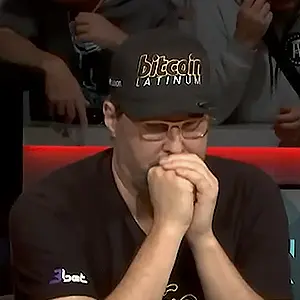Texas Hold’em Short Stack Strategy
George | April 21, 2010

Short Stack Strategy (SSS) is a term you will hear and read about a lot at the beginning of your poker career. It’s known to be one of the simplest poker strategies to play. More importantly, it’s one of the safest possible strategies to apply, making it very hard for your opponents to beat.
Because of its simplicity, applying this beginner poker strategy will help many players build up their initial bankroll. Most poker coaches will advise Short Stack Strategy for beginner No Limit Texas Hold’em players.
The principles of short stack strategy
First of all, you should know that Short Stack Strategy can only be applied when playing full ring games with 7 players or more. As soon as a table reaches fewer than 7 players, you will have to get up and find a new table to play at.
Another thing to watch out for is players who also apply Short Stack Strategy. Obviously, your winning chances will diminish the more players use this tactic when playing poker.
As mentioned before, playing the Short Stack Strategy is very simple. Once you’ve found a table that suits you, buy-in for the minimum table amount (which usually is 20 big blinds).
Now that you know this, you should not have any problems recognizing SSS players, as they will always buy in for the minimum amount allowed at the table, just like you.
Since Short Stack Strategy is a very aggressive type of poker strategy, a rule of thumb is that you will never be calling. It’s either raise (including shoving all-in) or fold.
Things to keep in mind
- It only works with No Limit Hold’em.
- Only sit down at full ring games with 7 or more players.
- Always buy-in for the minimum table amount.
- Only raise (all-in) or fold (no calling).
- Only play premium poker hands in the right position.
Pre-flop starting hand requirements for SSS

There’s a safer way of applying the Short Stack Strategy using the recommended starting hands, or you can take a little more risk by using the starting hands Phil Hellmuth wrote about in one of his poker books.
Personally, I’d recommend the following approach, especially if you’re a beginner. You can expand your range of starting hands once you seriously get the hang of it.
Starting hands
PokerStrategy.com recommends playing cards starting at pocket 7s and up, but please take into account your position at the table and any actions players in front of you might have made.
SSS when nobody has opened
Raise with any of the following hands:
- Early position: JJ – AA, and AK
- Middle position: 99 – AA, and AK AQ
- Late position: 77 – AA, and AT AJ AQ AK KQ
Your default raise should be four times the big blind, including an extra big blind for every other poker player who has limped in.
SSS when someone has raised
Move all-in with any of the hands in the following situations:
- 1 raise ahead of you: JJ – AA, and AK
- 2 or more raises ahead of you: KK AA
- When your opening gets re-raised: TT – AA, and AK
Short stack strategy guide
Now, let’s briefly talk about the more aggressive SSS approach Phil Hellmuth came up with. He recommends shoving all-in before the flop with any hand in the range of 22 to AA, plus AQ and better. The main reason for this is the probability that these types of hands will occur.
I would highly recommend Phil Hellmuth’s approach because, as you get better at poker, you should start learning more poker strategies, such as the Big Stack Strategy, besides SSS. Until then, it’s better to be on the safe side. If you want to know what the poker pro recommends, I suggest you buy his book “Play Poker Like the Pros” or do some research on the internet.
Let’s carry on. As you have now learned the basic principles of how to apply the Short Stack Strategy before the flop is dealt, remember that in case you have moved all-in and one of your opponents decides to call you, you can sit back and relax. You’re perfectly fine since you’re only playing premium hands, and in case of a call, you’ll end up having the best hand most of the time.
Post-flop short stack strategy
But what should you do after the flop if you didn’t shove all your chips to the middle, but only made a standard raise as described above? Your consecutive play completely depends on the cards dealt on the flop.
Did the flop bring you a monster (flush or straight), or did you hit top or middle pair? Maybe you didn’t hit anything at all, but are now holding a drawing hand—either a flush draw or an open-ended straight draw—after the flop? Of course, any overpair is great too, even if the flop didn’t improve your pocket hand.
Playable post-flop SSS hands
- Flush or better
- Straight
- Overpair
- Top pair (only when you raised pre-flop and your kicker is at least a Jack)
- Middle pair (only when you raised pre-flop)
- Flush draw (only when you raised pre-flop)
- Open-ended straight draw (only when you raised pre-flop)
As you can see, you will have to apply an even more conservative way of playing after the flop if you haven’t raised before the flop (thus only when positioned on the big blind). Without a pre-flop raise, you will not continue to play hands that still need to improve. You should only play top pair (Jack or a better kicker) and overpairs or better hands.
For all the cases mentioned above, applying Short Stack Strategy to your game simply means that you should continue playing the hand. If you are holding anything worse, make sure to back up and fold unless you are given the option to see the turn card for free.
SSS actions after the flop
- When nobody has opened ahead of you: Bet about 2/3 of the pot (if 2/3 of the pot is more than half your stack, move all-in).
- When facing a bet ahead of you: Move all-in.
- When your opening gets re-raised: Move all-in.
There’s one important exception that allows you to continue playing the hand when you didn’t hit on the flop. If you are heads-up (meaning you are playing against just one opponent), you can make a bluff by betting 2/3 of the pot. You either pick up the pot at once or give up and fold when your opponent doesn’t back up.
SSS actions after the turn
- When someone has called your bet on the flop: Move all-in.
You have now learned the basic principles of SSS, including how to apply this strategy before and after the flop. The only remaining ingredient for a profitable poker career is bankroll management.
If you do everything we have written in this short guide, plus apply proper bankroll management, then you should soon be ready to play at higher limits!